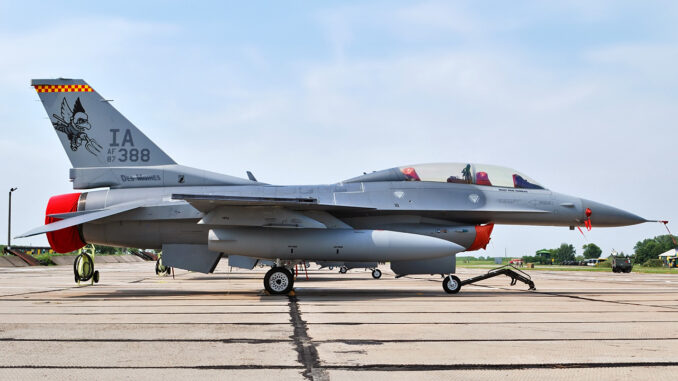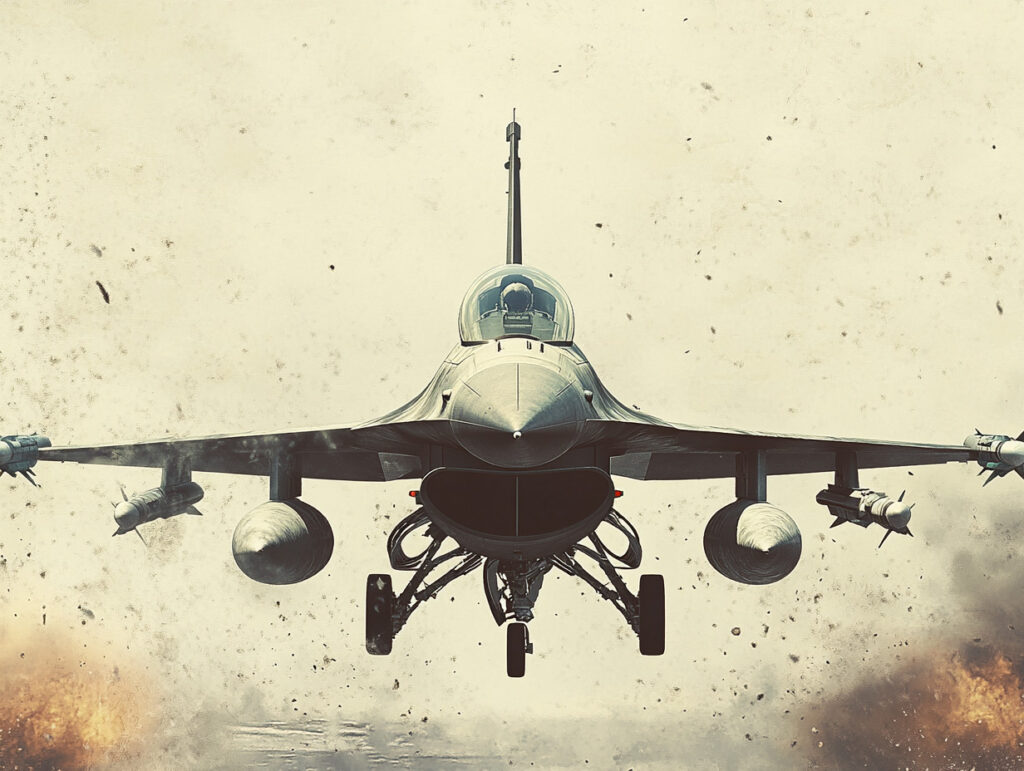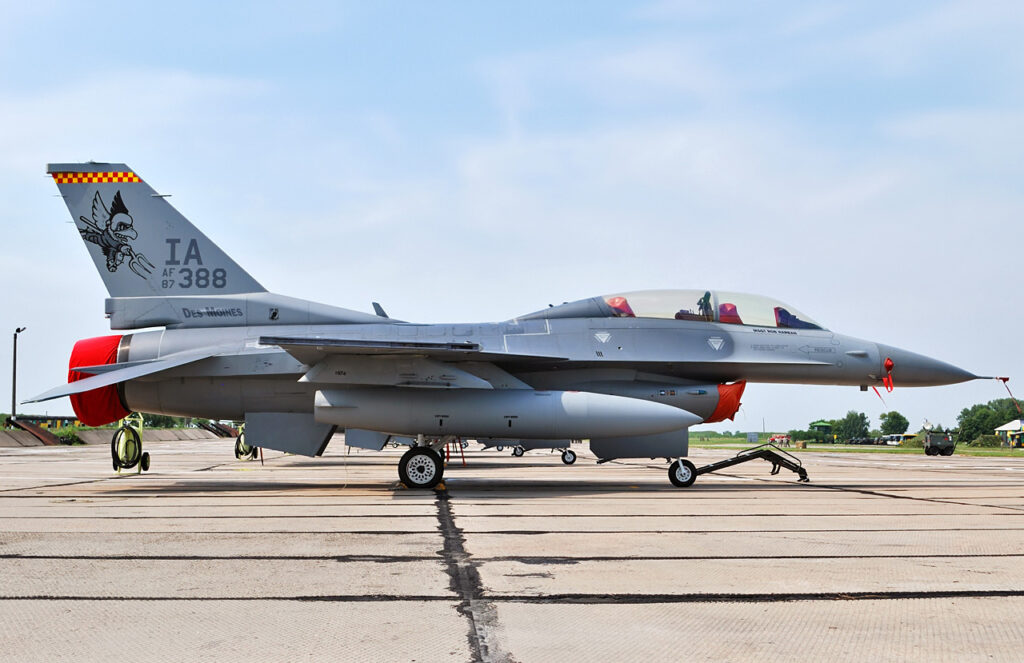
The F-16s enter service in Ukraine with advanced protection systems. Technical and strategic analysis of their impact on warfare.
F-16 fighter jets have officially joined the arsenal of the Ukrainian Air Force, marking a turning point in the ongoing war with Russia. This article details the technical aspects and strategic implications of this acquisition, exploring integrated protection systems, compatible munitions and the challenges associated with their deployment. The F-16, equipped with advanced technologies such as the Pylon Integrated Dispensing System Plus (PIDS+), promises to improve Ukraine’s air defence while presenting significant operational challenges. Find out how these fighters could transform Ukraine’s air warfare landscape.

The arrival of the F-16 in Ukraine: context and strategic issues
The integration of the F-16s into the Ukrainian air force marks a crucial stage in the ongoing war with Russia. This event is the result of lengthy diplomatic negotiations between Ukraine, the United States, Denmark and the Netherlands. The acquisition of these fourth-generation fighters represents a significant boost to Ukraine’s military capabilities, particularly in the field of air defence.
As multi-role fighters, the F-16s offer greater operational flexibility. They are capable of carrying out air defence, ground attack and reconnaissance missions, making them particularly well suited to Ukraine’s current needs. This flexibility is essential to counter Russian air superiority and protect Ukraine’s critical infrastructure.
However, the integration of these fighter aircraft requires significant logistical support and a strengthening of the Ukrainian army’s technical capabilities. The F-16 is a complex aircraft, requiring extensive training for pilots and maintenance personnel. It is estimated that it takes several years for an F-16 pilot to become fully operational, which poses short-term challenges for Ukraine. In addition, the ability to maintain a constant flow of new pilots is crucial to maximising the effectiveness of these aircraft.
In conclusion, the arrival of the F-16 in Ukraine considerably strengthens the country’s military capabilities, but the road to optimal use of these aircraft will be long and fraught with challenges. It is imperative that Ukraine continues to invest in the training and development of its personnel in order to take full advantage of these new acquisitions.
F-16 capabilities: an improvement in Ukrainian air defences
The F-16s represent a major step forward for Ukraine’s air defence capabilities. These aircraft are equipped with sophisticated systems such as the AN/APG-66, a multi-mode radar that improves target detection and tracking. Although this radar is not as powerful as the Active Electronically Scanned Array (AESA) radars found on more recent fighters, it nevertheless represents a quantum leap compared with the MiG-29 systems of the Soviet era.
The Ukrainian F-16s are also equipped with AIM-9M and AIM-120 AMRAAM air-to-air missiles, enabling them to counter air threats effectively. These missiles are widely used by NATO forces, providing Ukraine with a continuous supply of ammunition, unlike the limited stocks of Soviet missiles. The use of these missiles, combined with the detection capabilities of the AN/APG-66 radar, enables the F-16s to provide effective air defence over the whole of Ukrainian territory.
In addition, the F-16s are capable of using a wide range of NATO-standard munitions, including laser-guided bombs and cruise missiles, which broadens their operational spectrum. This versatility is crucial for Ukraine, which has to deal with a wide range of threats, from drones to cruise missiles. For example, the integration of GBU-39/B Small Diameter Bombs enables the F-16s to carry out precision strikes on distant targets, which is essential for hitting targets deep in Russian-controlled territory.
The acquisition of the F-16s therefore enables Ukraine to strengthen its air defence while increasing its offensive capabilities. However, optimum use of these aircraft will require an ongoing effort to develop the technical and operational skills needed for their effective deployment.
Advanced protection systems: pylon integrated dispensing system plus (PIDS+)
The Ukrainian F-16s are equipped with advanced protection systems, such as the Pylon Integrated Dispensing System Plus (PIDS+), which considerably improve their survival in hostile environments. The PIDS+ incorporates several electronic warfare technologies, including missile warning sensors (MAWS) that provide near-spherical coverage to detect incoming threats.
These systems enable the F-16 to detect and counter potential threats such as surface-to-air missiles and air-to-air missiles. In addition to MAWS sensors, the PIDS+ includes flare and chaff launchers, which can deflect infrared or radar-guided missiles. These countermeasures are essential to ensure the survival of aircraft in an airspace saturated with Russian anti-aircraft defence systems.
The PIDS+ system can be combined with the Electronic Combat Integrated Pylon System Plus (ECIPS+), which adds further electronic warfare capabilities. ECIPS+ incorporates Northrop Grumman’s AN/ALQ-162(V)6 radio frequency countermeasure system, which jams enemy radars and reduces the likelihood of detection by them. This combination of protection systems provides the F-16 with increased survivability, even in the most dangerous environments.
The integration of these protection systems is particularly important in the Ukrainian context, where Russian forces have a wide range of air defence systems at their disposal, including the S-400 systems, which are renowned for their effectiveness. By equipping its F-16s with these advanced technologies, Ukraine is strengthening not only its air defence capability, but also the protection of its critical infrastructure and ground forces.
The challenges of integrating the F-16 into the Ukrainian Air Force
Despite the significant advantages that the F-16s bring to Ukraine, their integration into the Ukrainian Air Force poses considerable challenges. The first challenge is pilot training. As mentioned earlier, it takes several years for a pilot to become fully proficient on the F-16. This lengthy and costly training also requires the establishment of specific infrastructures, such as flight simulators, which are essential for developing pilots’ skills.
In addition to pilots, maintenance personnel must also be trained to maintain these aircraft autonomously. F-16s require in-depth technical knowledge and practical experience with complex propulsion, avionics and electronic warfare systems. Maintaining these aircraft also requires specific spare parts, which must be available in a timely manner to avoid prolonged periods of aircraft unavailability.
Another major challenge is protecting the F-16s on the ground. The air bases where these aircraft are stationed are prime targets for Russian strikes. Ukraine will have to implement robust protection measures, such as dispersing the aircraft over several sites, using reinforced hangars and improving the anti-aircraft defence systems around the bases. These measures are crucial to ensuring the operational availability of the F-16s and avoiding losses on the ground.
Finally, maintaining a constant supply of ammunition and spare parts is a major logistical challenge. The F-16s use standard NATO ammunition and parts, which requires close coordination with Western allies to ensure a continuous flow of these resources. This dependence on external supplies could pose problems in the event of disruptions to supply chains or changes in the priorities of supplier countries.
Strategic consequences of F-16 integration in Ukraine
The integration of the F-16s into the Ukrainian air force has important strategic consequences for the ongoing war and for the balance of forces in the region. Firstly, these fighters strengthen Ukraine’s ability to defend its airspace against Russian incursions, which could deter future air attacks and reduce the freedom of action of Russian forces in Ukrainian skies.
In addition, the F-16s’ ability to use precision munitions, such as JDAM-ER bombs and cruise missiles, enables Ukraine to carry out targeted strikes against Russian military infrastructure, even in heavily defended areas. This long-range strike capability could alter the Kremlin’s strategic calculations, increasing the costs and risks associated with continued aggression in Ukraine.
The introduction of the F-16 could also have an impact on international relations, by strengthening the ties between Ukraine and its Western allies. The technical and military assistance required to integrate the F-16s implies close cooperation with NATO countries, which could strengthen Ukraine’s integration into Western defence structures.
On the other hand, the acquisition of F-16s could also lead to an escalation of tensions with Russia, which could perceive these aircraft as a direct threat to its national security. This perception could lead Russia to intensify its military efforts in Ukraine or to take retaliatory measures against countries providing military support to Ukraine.

Towards a new era for Ukrainian air defence
The arrival of F-16s in the Ukrainian air force marks a decisive turning point in the ongoing war with Russia. These fighter jets offer Ukraine an unprecedented air defence and precision strike capability, while posing significant logistical and operational challenges. The successful integration of the F-16s will require a sustained effort on the part of Ukraine and its allies, but it could also change the balance of power in the region and influence the course of the war.
War Wings Daily is an independant magazine.